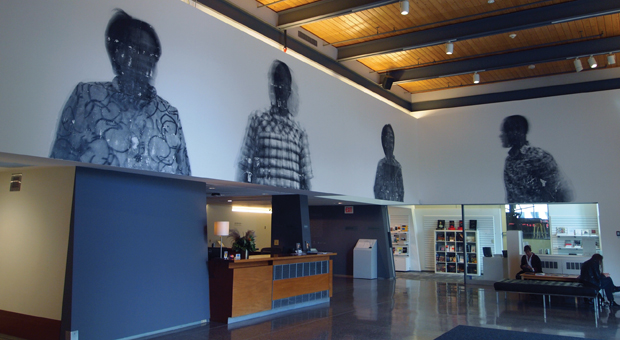Toronto-based artist Sandra Brewster chronicles movement through Blur, a photo exhibit on display in the Agnes now.
Mounted above the administration desk at the Agnes Etherington Art Centre, Blur will be hanging there until Sept. 6, 2021.
As Brewster’s latest project, Blur focuses on three members of the Kingston community, one of whom is featured twice.
The artist started working on the piece over a month ago, started with a photoshoot in Kingston, before returning to Toronto to work on the images. Though this particular series is only about a month old, it’s not the first Blur series Brewster has created.
“I began a couple of years ago where I would ask people to pose in front of the camera, but also to move, and when I take an image of them, I can capture the movement in their faces and sometimes in their bodies,” Brewster said in an interview.
These four images were taken at low shutter speeds to capture various stages of movement—making the photos appear blurred.
“The idea behind it was to allude to a movement from one place to another place, […] my family is from Guyana, so I always allude to the movement of them leaving Guyana and coming to Toronto,” Brewster said.
By representing other people’s physical movement through her photography, she’s able to reflect the larger-scale movement of Black families and individuals in Canada.
“It’s a change of home from one place to another place. I wanted to use a bare-bones kind of method and use the actual action of movement to bring out some ideas around what happens to one’s identity when they make such a move,” she explained.
Brewster’s process involves printing out the image and then using a gel gloss medium to cover the image and the surface she’s working on. She then holds the two together face-to-face and wipes off the paper after it’s dry, leaving the transferred ink on the surface. Creases and areas where the ink didn’t fully transfer remain, giving the finished product an aged appearance.
“This adds to the impression of the piece and the idea of another time,” Brewster said. She’s been working in this style since 2004.
Much of Brewster’s art deals with themes of aging, moving, and memory.
Right now, she has an exhibition video at the YYZ Gallery in Toronto. It shows the sanding and painting of a transfer photo she made two years ago.
“The image that’s [in the exhibit] was an image of a family when they were touring from the area of the Caribbean.”
The art shows the family standing on a hilltop, surrounded by only nature.
“The thesis was […] bringing the experience of another place into the gallery,” she said. “It symbolized the permanence of this image within a space within the architecture of this building.”
The video shows that no matter how much the transfer is sanded down, the image can’t be removed. “It’s always there,” the artist said.
She went on to explain that “when I do my work, I have my intentions and I hope that some of that comes through, but I’m aware that everybody comes with themselves to the work and so I’m hoping that they see what I see, and at the same time.”
Through these intentions, Brewster’s art captures people’s physical activity: their everyday movements, and their relocations across the world.
Blur invites gallery-goers to be witness to this and take from it what they choose.
“I accept that I don’t have that control anymore after I put work out there,” the artist said.
Tags
Agnes Etherington Are Centre, Gallery
All final editorial decisions are made by the Editor(s)-in-Chief and/or the Managing Editor. Authors should not be contacted, targeted, or harassed under any circumstances. If you have any grievances with this article, please direct your comments to journal_editors@ams.queensu.ca.

